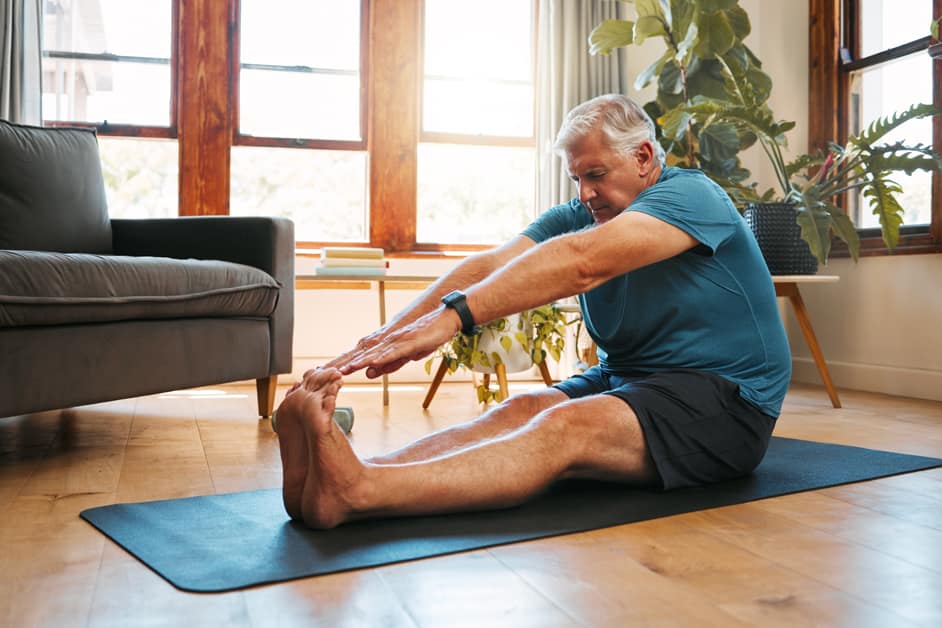Introduction
Dynamic stretching is growing fast as an exercise to help ease knee pain. It uses controlled, repeating movements to better flexibility and reduce injury risk. This is different from static stretching, which holds a muscle in an extended position for a time.
Dynamic stretching targets specific areas and stretches past what the body can do naturally. It offers great benefits for people with knee pain.
What is Dynamic Stretching?
Dynamic stretching is different from static stretching. It involves movement, to increase flexibility and range of motion of the joints and muscles. You move your body or limbs, in controlled actions and pauses. This form of stretching can be done anywhere and anytime.
Dynamic stretches are great for people with knee pain. They target the muscles and help keep the joint fluid and flexible.
- Squats
- Forward lunges
- Side shuffles
- Step-ups
- Calf raises
are all effective stretches. These can warm up your body before activity, and help with recovery after activity.
Benefits of Dynamic Stretching
Dynamic stretching? A-mazing! It boosts flexibility, range of motion and, bonus, helps relieve knee pain. Plus, it preps your body for physical activity or exercise. And, the benefits don’t stop there. Dynamic stretching can improve performance, avoid injury and decrease soreness post-workout. Boom! Knee pain relief!
Improves Range of Motion
Dynamic stretching is an active form of stretching. It gives a greater range of motion than static stretching. This can help with speed, agility, and flexibility -all important for physical performance. It also helps coordination and proprioception.
Dynamic stretches move joints through their full range of motion. Doing this builds strength and endurance in muscles. It can help with knee pain. It reduces strain on the knees, and increases blood flow. This helps reduce muscle soreness and repair soft tissue damage.
Dynamic stretching involves the stretch-shortening cycle. This builds strength and helps with sprinting speed. It increases power output from muscles used in sprinting.
Increases Blood Flow
Dynamic stretching is a sequence of movements that lengthen muscles. It’s done in a controlled and continuous way, with an emphasis on a full range of motion. This type of stretching increases blood flow throughout the body, helping muscle coordination. It also targets specific muscles, making them better prepared for physical activity.
Increased blood flow makes it easier for muscles to work at their best. Improved core strength helps with posture and reduces stress on the knees. Circulation also helps reduce swelling from injuries. Combining dynamic stretching with strength training or aerobic activity increases endurance and flexibility. This helps prevent impairments caused by inactivity or over-working muscles.
Dynamic stretching is vital for any fitness routine. It gets the body ready for movement, increases flexibility and muscle activation, and reduces injury risk. The exercises should resemble real-world activities such as lunges, squats and step-ups, while keeping multiple joint motions within one movement. When doing dynamic activities, slowly build up intensity until desired results are achieved. This leads to improved range of motion which can help with knee pain relief when combined with exercises to strengthen weak muscles.
Enhances Joint Mobility
Dynamic stretching is active. You move your joints and muscles through a range of motion. Each stretch only takes a few seconds. When you do this regularly, it increases joint mobility. This helps the connective tissue stay strong. Especially helpful for athletes, dancers, and people who move quickly or suddenly.
Dynamic stretching also has great benefits. It increases blood flow and reduces muscle tension, helping you stay safe when you exercise or do activities. It helps your muscles contract and become more flexible. Finally, it’s good for your mind. It boosts your focus and reduces anxiety before physical activity.
Improves Muscle Strength
Dynamic stretching is active and boosts range of motion. Unlike static stretching, where one position is held for +30 seconds, dynamic stretching is continual movement and pushing the body’s limits. Move back and forth in a controlled way, exaggerating the desired range of movements. Examples are arm circles, leg swings, or trunk twists.
The benefits of dynamic stretching are numerous! It improves muscle strength and power, faster recovery times, joint mobility, running faster, balance coordination, reduce injury risk, relieves tight muscles and improves posture. Regular practice brings immediate performance improvements and long-term positive effects on joint function and muscular health.
Dynamic Stretching for Knee Pain Relief
Dynamic Stretching – a fantastic approach to knee pain relief! This stretching style works by using movements that condition the body. It increases flexibility and range of motion. Dynamic stretching is an efficient, full-body warm-up. Let’s explore its specific benefits for those with knee pain.
Improves Flexibility
Dynamic stretching is not like traditional stretching. It is a form of stretching that incorporates movement. The individual must move in and out of positions. This type of stretching mimics planned activity. It can help increase flexibility and avoid potential injuries during physical activity.
Dynamic stretching can help ease knee pain. It stretches muscles while moving in full range of motion, without stressing the joints. Examples of effective dynamic exercises are:
- Lunge actions with opposing knee lifts
- Squats
- Reverse lunges
- Front kicks
These can help ease knee pain, increase flexibility and improve coordination.
Reduces Inflammation
Dynamic stretching is a beneficial exercise. It fights inflammation and knee pain. You just need your body weight and no extra equipment.
Dynamic stretching strengthens stabilizing muscles and boosts circulation. Engage your core and move slowly to avoid momentum. Target tight or weak muscles caused by an old injury or chronic condition. Do the exercises at a steady pace and build strength and balance with repetition. This increases flexibility and mobility. It will give you greater range of motion, reducing inflammation around the knees.
Strengthens Muscles
Dynamic stretching is a type of physical activity that helps strengthen muscles and improve flexibility. It uses large range of motion movements over small, controlled ranges. Improving flexibility can help with knee pain relief.
To target the major muscles around the knees, exercises such as glute bridges or step-ups are useful. These help boost strength around the knee joint area.
For improved stability around the lower leg, exercises like hip abduction or lateral leg raises are beneficial. Plyometric exercises like jumping jacks or skater lunges help with balance and agility. Doing this type of training strengthens key muscle groups that protect your knees. This reduces pain and discomfort caused by conditions such as osteoarthritis or chronic inflammation.
How to Perform Dynamic Stretching
Dynamic stretching is fab for relieving knee pain and improving joint flexibility. It’s all about gradual movements going from one body position to another and controlling your muscles. Doing this increases flexibility and reduces discomfort in the knees and hips.
Important: Use correct form and technique – else an injury might occur! To get it right, warm up with light aerobic activity like walking or jogging. Move slowly, breathe normally and keep movements within a comfortable range of motion. Do each stretch 8-10 times per side and hold for 20 seconds.
You can do dynamic stretching almost anywhere. As you become more familiar, add complex movements that challenge balance, coordination and strength.
Conclusion
Dynamic stretching is great! It can help ease knee pain, enhance performance and reduce injury risk. Before physical activity, athletes or those with knee pain should include dynamic stretching in their warm-up routine.
If a person has chronic knee pain, it’s best to find a qualified professional such as a physical therapist or coach. This way, their form and technique will be correct, and they can maximize the advantages of dynamic stretching for their specific problem.
Frequently Asked Questions
Q1: What is dynamic stretching?
A1: Dynamic stretching is a type of exercise that involves controlled, rhythmic movements that gradually move the joints and muscles through their full range of motion. It is designed to help increase flexibility, improve balance and coordination, and reduce the risk of injury.
Q2: How can dynamic stretching help with knee pain relief?
A2: Dynamic stretching can help improve the flexibility, strength and stability of the muscles and joints around the knee. This can help reduce stress on the knee joint and improve overall knee function, helping to reduce pain and discomfort.
Q3: What type of dynamic stretching exercises are best for knee pain relief?
A3: Some of the best dynamic stretching exercises for knee pain relief include leg swings, butt kicks, and high knee walking. These exercises can help improve flexibility, strength, and stability in the muscles and joints around the knee, helping to alleviate pain and discomfort.





